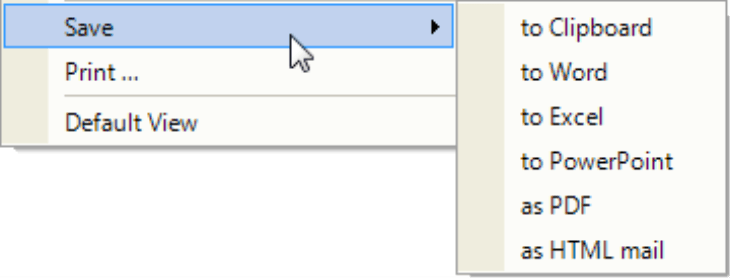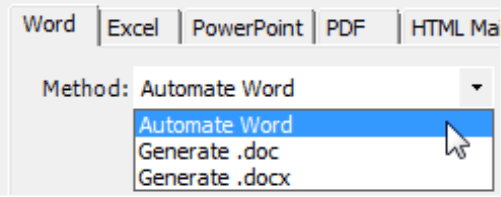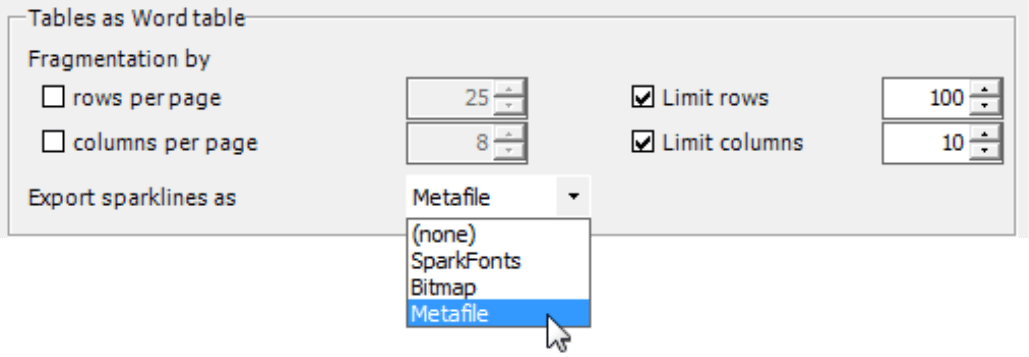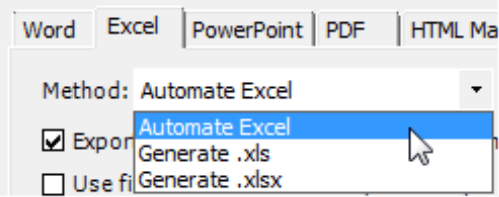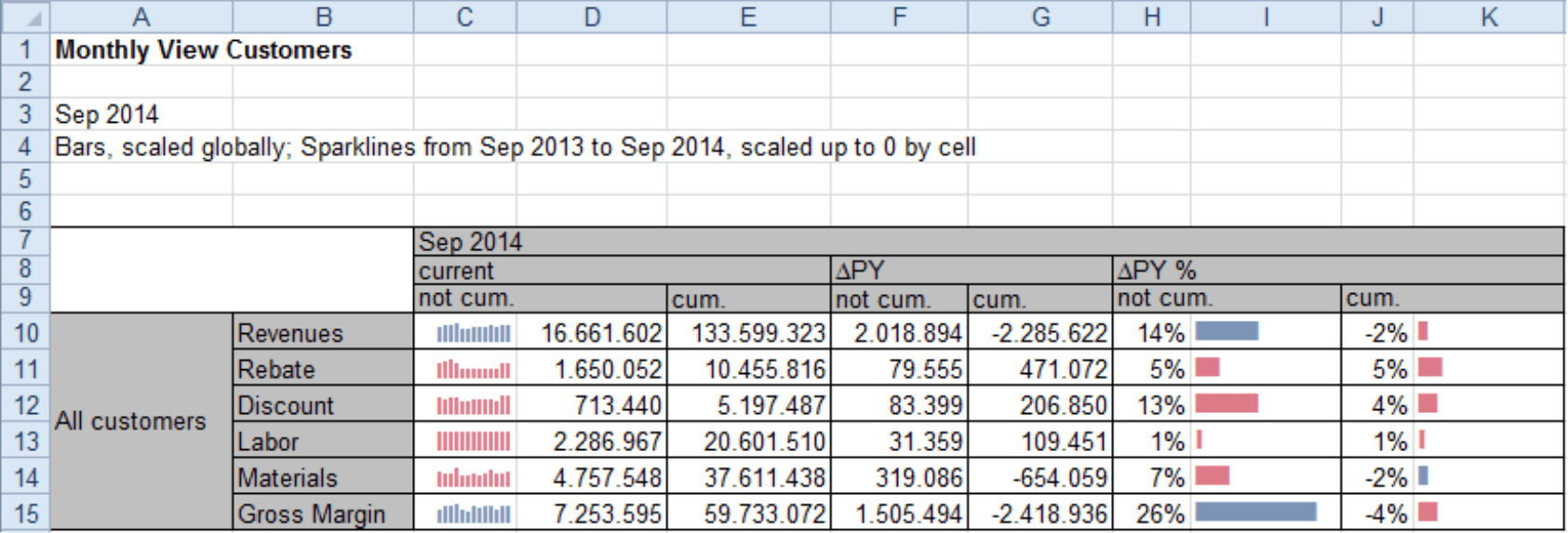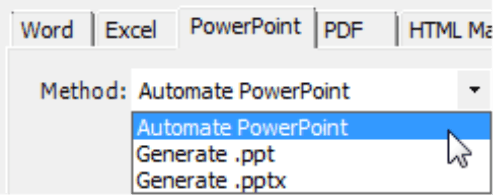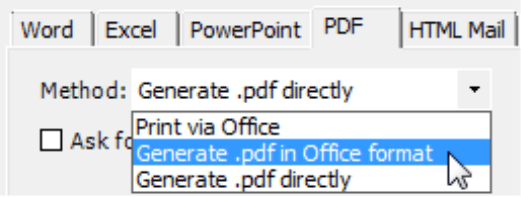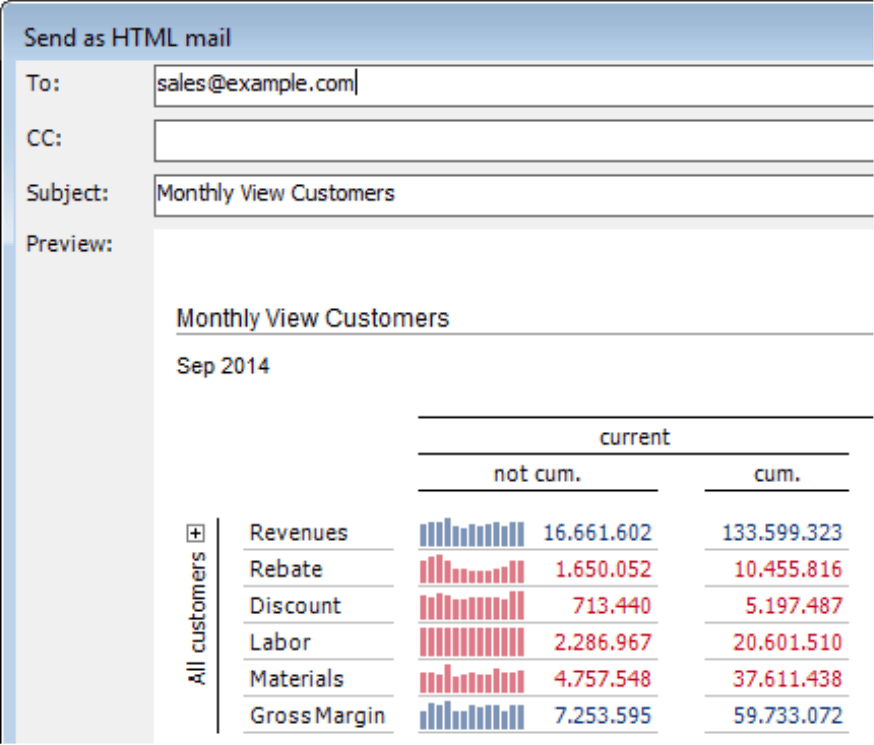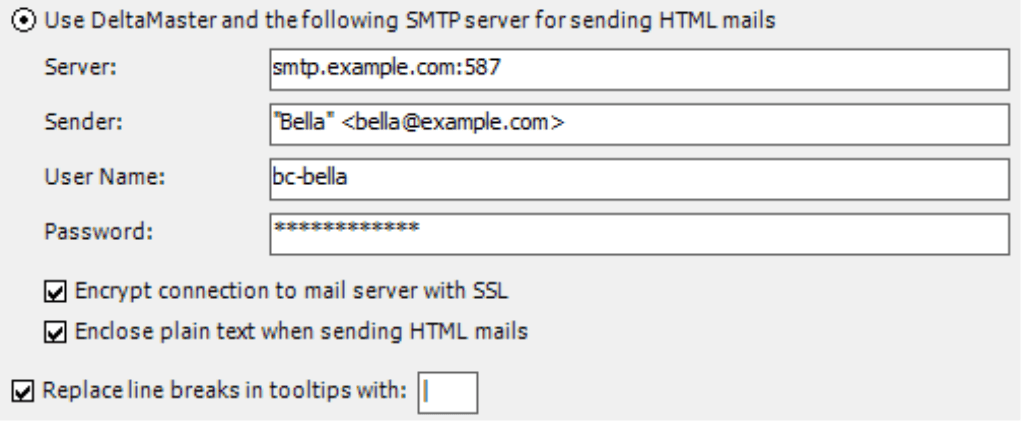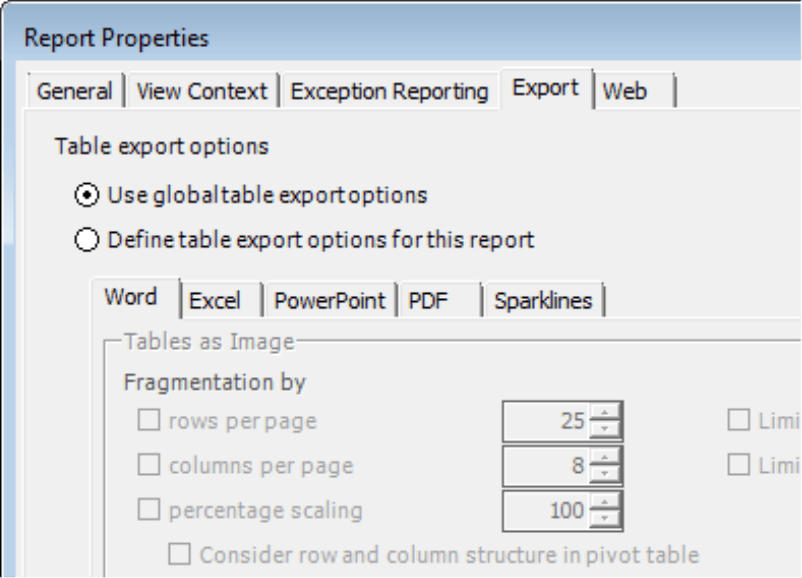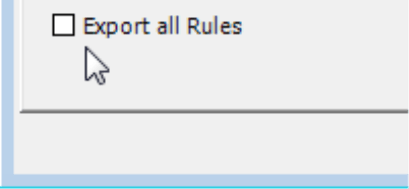Greetings, fellow data analysts!
You don’t just create reports for your own personal use, but rather to spread the news to everyone involved. To do that, you often need the prevalent document formats in addition to the DeltaMaster-specific ones. You probably use Word to draft elaborate copy, rely on PowerPoint for speeches and presentations (in spite of its weaknesses and all the criticism), and make small calculations in Excel. If you observe something in a report, you simply send an image by email. DeltaMaster can export information to these formats quickly and without bogging you down with technical questions. It summarizes alternative methods into just a few options which serve as global default settings that can be altered for individual reports. Chances are that you have never taken a closer look at these options – because you don’t have to. Should you ever need to take a peek behind the scenes and make a few adjustments, however, you will find everything you need to know in this edition of clicks!.
Best regards,
Your Bissantz & Company team
Using the export function of DeltaMaster, you can transfer reports to Microsoft Word, Excel, or PowerPoint with just a click of a mouse. You will receive (printable) documents with clean designs that don’t require any further tweaking because their structure and appearance are already defined in DeltaMaster. The actual export, therefore, only requires a few additional settings. They are primarily necessary because DeltaMaster needs to break down tables to distribute them among pages, worksheets, or slides. That, after all, is a major difference to DeltaMaster, which displays data continuously on the screen so that you can interactively navigate it as you wish in a flowing manner. To display this data in all other formats, DeltaMaster has to divide it up and adapt it to the respective visualization units. In the sections below, we will introduce the parameters that you can use to modify this procedure.
Global default setting
You can edit the default settings under Options (Extras menu) on the Export tab; no analysis session or application must be open. In addition, you can adjust the settings for each individual report.
The Export tab is broken down into nine sub-tabs, one for each export target. These include tabs for the common Microsoft Office formats (Word, Excel, PowerPoint), for PDF, for sending reports via email (HTML Mail), for Mobile briefing books on iPad/iPhone devices, for Print, and for the Clipboard. The final tab contains detailed settings for Sparklines.
The settings under Options serve as the global default for all analysis sessions or applications for one user on one computer. These settings are saved for each user in the Windows Registry (“HKEY_CURRENT _USER”). DeltaMaster saves the options for specific reports in the analysis session or application (see below for more information).
Options for exporting to Microsoft Word
For many users, Word is the most important format for sharing DeltaMaster reports – either as a printed briefing book with additional information or as an electronic document. The options for exports to Word are split into five sections. Since they reappear in a similar form in other formats as well, we will explain these options here in more detail:
Export method
You must first select the desired method: Automate Word or Generate .doc/.docx files. You will find this same differentiation for exports to Excel and PowerPoint.
- Automate: DeltaMaster sends commands to Word to create the document there – as if Word is “remotely controlled”.
- Generate: DeltaMaster creates Word files, i.e. Office 2000/XP/2003 DOC files or Office 2007/2010/2013 DOCX files, without accessing Word itself. The format version is irrelevant in automation because the user can opt to save the documents in either format. When you generate the files, you can specify if DeltaMaster should ask for a file name. If not, DeltaMaster will save the DOC or DOCX files under the automatically assigned name in the Export documents folder that is listed under Options on the Folder tab.
When generating the files, you can also specify if DeltaMaster should generate a static table of contents. This option is due to the peculiarities of the Word format: DeltaMaster will enter the table of contents as a field code into the document. The job of this field code is to dynamically adapt the table of contents based on the content in the document, for example, when you open the file or explicitly instruct it. If DeltaMaster generates the file without the help of Word, it will enter the field function correctly in the document but without calculating it. The user will have to update the field individually when opening the generated document for the first time. Alternatively, DeltaMaster can generate a static table of contents. This is included in the document completely from the beginning, however, without page numbers which Word also administers dynamically.
When should you choose which method?
- When you automate Word, you can use program-specific, interactive functions, for example, the automatic updates of page numbers in the table of contents.
- Generating is the significantly faster method. It also works on computers without a Microsoft Office installation.
All methods do their jobs with the help of a document template: “DeltaMaster.dot” for generating DOC files, “DeltaMaster.dotx”, “DeltaMaster.dotm”, or “DeltaMaster.dot” for generating DOCX files and for automating Word. DeltaMaster searches for document templates in the directory that is listed under Options on the Folder tab for Export templates (e.g. “C:Program FilesDeltaMaster 5.6.2Templates”). As part of the installation package, DeltaMaster includes a template (for the other formats as well) which you can adapt to your own needs.
Report types that are exported as an image
In the second section of the tab, you can select which table view you want to export as image. If any of these report types are not activated, DeltaMaster will “rebuild” the tables from these reports in Word.
- When you export as an image, the design of the report looks just like the original. You can easily arrange the images in Word or change their size by dragging them. Within the exported tables (i.e. within the images), however, you cannot make any changes.
- When you export as a table, you can later modify them, for example, by adding rows and columns, or renaming awkward captions (which you can also easily do in DeltaMaster as well; see DeltaMaster clicks!08/2014 for more information). On the other hand, the table will lose much of the elegant formatting (e.g. white style, horizontal dividers, row and column structuring through separation) that you know from DeltaMaster.
All report types that are not listed will be exported as an image.
Exporting tables as an image: fragmentation, limit, scale
The third section affects all report types that will be exported as an image as defined in the section above. Here you can define if and how these tables should be fragmented into individual images, if the output should be limited to a certain number of rows and/or columns, and if the images should be scaled to a certain size during the export.
- Fragmentation allows you to break down large tables onto several pages of a Word document. Here you define how many rows and/or columns should be output in an image (on a page). If these options are not activated, DeltaMaster will turn each table into a single image and, if necessary, reduce the size so that it fits on one page (see below).
- If you limit rows/columns, very large reports (e.g. material or order lists) will not be output in their full length or width. In most cases, you would sort these types of evaluations anyway so that the most important entries are placed at the beginning of the table.
- The percentage scaling affects the size of the exported images. If this option is not activated, DeltaMaster will select the scale so that the table completely fits on one page of the Word document, but at most 100 percent. In other words, it will automatically reduce the size of large tables, but not make a small one unnecessarily large. If you activate the percentage scale option, DeltaMaster will set the size of all tables to the desired scale, even if some no longer completely fit on one page and will be “cut off” as a result. The uniform scaling and, thus, font size in the tables gives a clean, calm appearance to the briefing book as a whole.
Activating the percentage scale is at the same time the precondition that the row and column structuring of pivot tables (i.e. setting in the Table Properties) remains when they are divided into blocks (i.e. so neighboring members that belong together are output on the same page). In addition, you must select Automate as the export method and may not limit the row and column number.
Exporting tables as Word tables: fragmentation, limit, sparklines
When exporting tables as Word tables (i.e. instead of as an image), DeltaMaster can split the report into blocks with a certain number of rows and/or columns or limit the number of rows and/or columns that it outputs. Scaling options are not necessary because you can adjust the measurements in Word or the used export template.
If the table contains sparklines, you can add them to table cells as a bitmap, metafile (see below), or SparkFonts (see the section below on options for Excel). Metafiles and SparkFonts provide a clean, printable image. Metafiles are usually the first choice because they do not require special fonts.
Export format for charts and images: bitmap, metafile
DeltaMaster can export charts and images in one of two ways: as a bitmap or metafile. The setting is also valid for graphical reports (e.g. those in a Time Series Analysis, Trumpet Curve, or Portfolio Analysis) and tables that you export as an image.
- Bitmaps are comprised of pixels. They are well suited for all scenarios where a typical screen resolution is acceptable such as PowerPoint presentations displayed on an LCD projector or screenshots in an internal process handbook.
- Metafiles are based on vectors. You can print them as well as scale their size to make them larger or smaller. Although metafiles may appear somewhat rough or uneven on a computer screen, they are the first choice for print documents.
See the difference yourself in the following tables! The PDF file that you are reading right now is based on a Word document. Take a look at the tables on your screen, zoom in and out, and then print this page.
| Bitmap: |  |
| Metafile: |  |
Options for exporting to Microsoft Excel
When you export tables to Excel, the numbers will maintain their original accuracy including all decimal spaces. The export also transfers the number formatting to Excel so that the values will be displayed just as they are in DeltaMaster (e.g. with separators for thousands) but can be used for calculations without rounding errors. Exports as images to Excel are not supported.
Export methods
Just as with Word, you can export tables by automating Excel (“remotely controlled”) or generating files in your choice of Office 2000/XP/2003 (XLS) or Office 2007/ 2010/2013 (XLSX) formats. Similar to Word, the export is based on a template: “DeltaMaster.xlt” when generating the older file format or “DeltaMaster.xltx”, “DeltaMaster.xltm”, or “DeltaMaster.xlt” when generating the newer format or automating Excel.
When automating Excel, you can activate the option to export single analyses or reports to the currently opened workbook. This is very useful when you only temporarily need data in Excel, for example, to make a small control calculation on the side or to combine different analyses into a workbook. If the option is deactivated, DeltaMaster will create a new workbook for each export job.
When generating Excel spreadsheets, DeltaMaster can either ask you to enter a file name or automatically use a predefined name – just as in generating Word documents.
Further options
- For printing with Excel, DeltaMaster offers two options: Use fixed rows as rows to repeat at top and use fixed columns as columns to repeat at left. These options refer to the rows and columns that Excel outputs at the top or to the left of each printed page so that all printed pages are labelled. In Excel, these repeated rows and columns, which are also referred to as the print titles, belong to the page layout. Using these options, you can automatically set the fixed rows and columns in DeltaMaster as the rows and columns to repeat in Excel. DeltaMaster defines fixed rows and columns as those that do not move when you scroll a report – in other words, the row and column headings as well as the defined fixed sections of a FlexReport.
- Speaking of FlexReports: You can export these types of reports either with or without formatting (e.g. background colors, frames, font style, or font type).
- If the same caption appears next to each other or under each other in several cells of a pivot table, DeltaMaster can merge these cells in Excel so that the caption is only displayed once (with center alignment). DeltaMaster has a similar setting in the Table Properties of pivot tables, which you can use to quickly switch between merged and separated views.
- Finally, you can define that DeltaMaster should Export graphic elements (e.g. Bars, Columns, Waterfall Elements, Sparklines) from pivot tables and enter them into the cells of the Excel table. This option uses SparkFonts, a patented technique to reliably place the graphical elements into table cells. SparkFonts are special TrueType fonts that consist of thousands of line segments, bars, etc.
When merged together, SparkFonts create an optical impression of line or column charts. From a technical point of view, however, they are just a few characters. You can display sparklines also in older versions of Excel and print them with razor-sharp quality. No other technique can do that. Whereas Word offers a choice of bitmaps, metafiles, and SparkFonts, SparkFonts are the only viable option for Excel.
Options for exporting to Microsoft PowerPoint
Since PowerPoint lacks stable table objects to this day, DeltaMaster always exports tables as an image to this format. Aside from this aspect, the options for PowerPoint are very similar to those for Word.
Export methods
Similar to Word and Excel, you can export tables by automating PowerPoint (“remotely controlled”) or generating the files in your choice of Office 2000/XP/2003 (PPT) or Office 2007/2010/2013 (PPTX) format. The PowerPoint export is also based on templates: “DeltaMaster.pot” for generating files in the older file format; “DeltaMaster.potx” or “DeltaMaster.potm” for generating files in the newer format; and “DeltaMaster.potx”, “DeltaMaster.potm“, or “DeltaMaster.pot” for automating PowerPoint. Here, too, DeltaMaster can either automatically assign the file name when generating the file or ask you to enter one.
Exporting tables as an image: fragmentation, limit, scale
The options to fragment and limit the scope of the export as well as to scale the output are identical to those for Word. In addition to that, you can define the slide count for fragmenting the report. Please note that this count determines the output (i.e. the slide count that will be generated) and not the input (i.e. the total rows and columns to be exported). DeltaMaster breaks down and scales down the tables to the designated length. It will not make the tables larger because this option was not designed to make a PowerPoint presentation longer than it should be.
Export format for charts and images: bitmap, metafile
Just as with Word, you can select if DeltaMaster should export charts and images as a bitmap or metafile.
Exporting report comments
One clever detail is the option to choose a location for exporting comments: to the comment pane of the template, as a slide note, or to an additional slide.
- The comment pane is a text box of the respective PowerPoint template. In other words, the comment will be displayed on the same slide as the report.
- Comments in the slide notes are intended for the presenter only. Using this option, you can jot down your thoughts on a certain report as report comments directly in DeltaMaster and then transfer them as slide notes during an export to PowerPoint.
- When you export a report comment to an additional slide, DeltaMaster will enter that slide after the report that it references.
Options for exporting to a PDF file
Similar to Word documents, PDF files are very popular in reporting – most likely, because they cannot be easily modified and generally appear the same way to the report author and consumers.
Export method
You can produce PDF files in one of three ways:
- Print via Office: DeltaMaster will first build the export document by automating Word, Excel, or PowerPoint (“remotely controlled”). DeltaMaster will then send a print command to the respecttive program. This command starts the print output to a PDF printer driver. The respective Office product and a PDF printer driver must be installed on the respective computer.
- Generate .pdf in Office format: DeltaMaster will first build the export document by generating a Word, Excel, or PowerPoint file as described above. Afterwards, it will use a special component to convert it into a PDF file. The DeltaMaster installation contains all necessary components; no installation of Microsoft Office or a PDF printer driver is necessary.
- Generate .pdf file directly: This option, an independent export format, generates a report in an individual layout based on the export template “DeltaMaster.pdf”. This option does not require an installation of Microsoft Office or a PDF printer driver. The formatting options are limited in comparison to the other methods; however, the export is faster because it does not need to generate temporary files.
If you choose one of the first two options, DeltaMaster will always ask if it should run the PDF export in Word, Excel, or PowerPoint when you start the export. With the first option, you will have to select the (virtual) printer which generates the PDF file.
So when should you choose which method? Printing via Office is well suited for end users that interacttively work with DeltaMaster and occasionally save their results as a PDF file. Generating PDF files in Office format is the best option if the computer you are using has no installation of Microsoft Office or you frequently export complex briefing books (and speed, therefore, is a key issue). Although directly generating PDF files is the fastest option, the formatting options are limited and editing the template is a time-consuming endeavor that requires special PDF tools (e.g. Acrobat Pro). As a result, you should only choose this export method in special cases.
Exporting tables: fragmentation, limit
If you choose to directly generate PDF files, you can create fragmented tables and limit the number of rows and columns that you wish to export, just as you can for Word and PowerPoint. In the case of the other two export methods, the same options that are set for the respective Office format are valid.
Options for sending HTML mails
When you send a report via email, the reports are generally inserted as a bitmap into a message with HTML formatting. This ensures that the email is always displayed the same way for all users and is simple to answer and forward. Nowadays, you also need to consider that people regularly read their email through small apps on a smartphone or via webmail interfaces – and not just through powerful desktop programs such as Microsoft Outlook. These systems often have major functional limitations with regards to their visualization options. With a bitmap, therefore, you are always on the safe side. For SQL Drill Through reports, you can even generate a pure HTML display in place of bitmaps (see DeltaMaster deltas! 5.6.1, feature #1 for more information).
Export methods
You can send email using either Microsoft Outlook or a proprietary DeltaMaster component.
If you use Outlook for sending HTML mails, DeltaMaster will generate an email by automating Outlook (an export function that is similar to the one used in other Office applications) and enter the DeltaMaster reports in the Outlook message. Afterwards, you can edit and send the message as usual. If you usually work with Microsoft Outlook, you should use this program in combination with DeltaMaster as well.
The proprietary DeltaMaster component is primarily designed for environments that do not use Outlook, for example, companies that work with IBM (Lotus) Notes. To create a message, DeltaMaster will open a simple dialog box that displays a preview of the reports that you wish to export. You can enter the addresses of your recipients and a subject line but not the text itself.
To send the email, DeltaMaster will transfer it to a mail server (SMTP). All access parameters must be defined in the options. The Password will be encrypted and saved in Windows Registry. For security reasons, we recommend that you encrypt the connection to the mail server with SSL. On a side note to all network experts, this option uses STARTTLS encryption (RFC 3207).
If desired, you can enclose a plain text version along with the HTML email. This has the advantage that you can also read and process messages when the email client does not support HTML (e.g. in a preview on a smartphone). Although the content of the reports is only contained in the bitmap images in the text version, you still can read report titles, view descriptions, comments, and other important information from the pure text version. In addition, sending a message in both pure text and HTML formats may placate certain spam filters.
For Outlook, the DeltaMaster settings to the mail server, SSL encryption, and plain text are irrelevant because the server and the encryption is already set in Outlook and generating pure text versions depends on the respective Outlook settings.
Further options
The last setting on the tab applies to Outlook as well as the proprietary DeltaMaster components. When generating an email, DeltaMaster will also generate code for tooltips (e.g. the columns of sparklines). These tooltips can contain multiple lines and, therefore, line breaks. Not all email clients, however, support line breaks in tooltips. If desired, DeltaMaster can replace line breaks in tooltips with other characters or character strings such as “ | “.
Options for mobile briefing books
With DeltaMaster ReaderApp, you can also view briefing books on an iPad or iPhone. Export the folders that you wish to take along as a DMMOBILE file and transfer them to the device via iTunes or email.
- If you export image tiles, ReaderApp can also display larger reports, which otherwise could cause problems due to memory limitations of iOS.
- To improve the display quality on devices with high-resolution screens (i.e. retina displays), DeltaMaster can also output reports in a higher resolution than the standard one. You can still open the resulting DMMOBILE files on devices without retina displays, but these files will be significantly larger than the standard ones.
- Finally, you can also automatically fit reportsinto the device width. This ensures that all reports will be scaled larger or smaller to a certain degree in order to superiorly utilize the available screen space. The app automatically ensures that the larger or smaller size stays in a reasonable range so that large tables aren’t shrunken to a point where they become illegible and smaller tables will not be blown up to grotesque proportions.
Options for printing
DeltaMaster utilizes the print functions of Word, Excel, PowerPoint, or Adobe Reader/Acrobat to bring your reports to paper. In the case of Office programs, it automates the documents; in case of Adobe Reader/Acrobat, it directly generates a PDF file. Either way, DeltaMaster will automatically send a print command to the respective program following the export job. When printing reports DeltaMaster will prompt you each time if Word, Excel, or PowerPoint should be “remotely controlled”.
Options for exporting to a clipboard
Copying reports to the clipboard is also a type of export.
Just as in Word, you can copy tables (e.g. pivot tables, FlexReports and tabular views of analytic methods) either as text or an image. When you copy tables as text, you can reuse the values in other applications (e.g. for smaller calculations in Excel.) The text will be plain (i.e. no formatting) and separated by tabs. The numerical formatting will also be identical to the display on the table. The view description and explanations such as notes regarding the scaling of bars will be copied as well.
When you copy tables as an image, DeltaMaster will only transfer the actual report without view descriptions and explanations. The second selection field on this tab determines how to copy charts and images.
You cannot copy combined chart and table views (e.g. the Lorenz curve and table of a concentration analysis) to the clipboard.
Options for exporting sparklines
Both settings on the Sparklines tab refer to the output of sparklines as a metafile as you can use them when you export Word tables. If you activate the first option, DeltaMaster will export sparklines black-white. This option improves the legibility of line sparklines when outputting them to black-white printers. The second option influences the line width of line sparklines; a larger value will generate thicker lines.
Report-specific export options
As previously mentioned, the settings under Options (Extras menu) will be saved for each user as the global default setting for all reports. In addition, however, you can also define special settings for individual reports. These individual settings have priority to the global ones and are saved in the analysis session or application. You can edit the global export options in all user modes of DeltaMaster. Report-specific settings, however, can only be edited in the user modes that allow you to create reports (i.e. Pivotizer, Analyzer, and Miner).
You can change the settings for each individual report in the Report Properties (context menu of reports in the briefing book). The tabs in the Export section have the same set up as those in the Options but only show the parameters that are intended for working with tables. You cannot change the export methods for individual reports.
In the top section of the tab, you can decide if you want to use global table export options or define table export options for this report individually. The second option will activate the sub-tabs Word, Excel, PowerPoint, PDF, and Sparklines so that you can alter these settings.
Options for Word and PDF files
When you export to Word or PDF files, DeltaMaster will offer three additional options aside from those explained in the sections above.
The first option is only available for report types where you can export as an image and as a table to Word (i.e. pivot tables, Cross Table Analysis, Interdependency Analysis, FlexReport, Ranking, and PowerSearch). In these cases, you can decide if DeltaMaster should export the report using the global settings or, regardless of what these settings are, always as an image (yes) or as a table (no). The global setting is also displayed in the drop-down list.
In the Report Properties of DeltaMaster, you can also define if you wish to use portrait or landscape page orientation. The standard page orientation of the output document depends on the Word or PDF export template (e.g. “DeltaMaster.dot”, “DeltaMaster.pdf”) and not the settings in DeltaMaster. In the Report Properties, you can adjust the layout of the resulting report document to the content of the report so that wide tables are placed in landscape format and narrow ones are set in landscape – all in the same document. This option is valid even if you otherwise use the global table export options for this report.
Option for rule-generating methods
If you are working with reports in analytical methods that generate rules or alternative decisions, you can export all rules (or alternatives). This option will enter all tables, charts, and combined views where you can interactively switch back and forth in DeltaMaster into the target document. This option applies to Comparator, Descriptor, Profiler, and Navigation. There is no global setting for this option and it cannot be changed; in the default setting, only the actual rule will be exported.
Questions? Comments?
Just contact your Bissantz team for more information.
